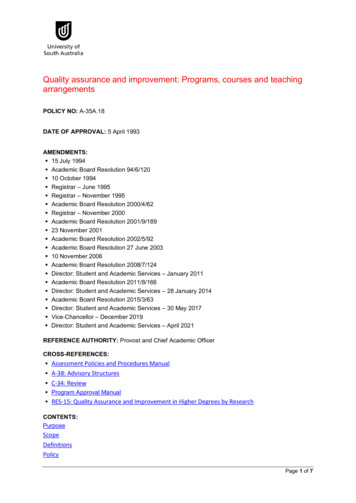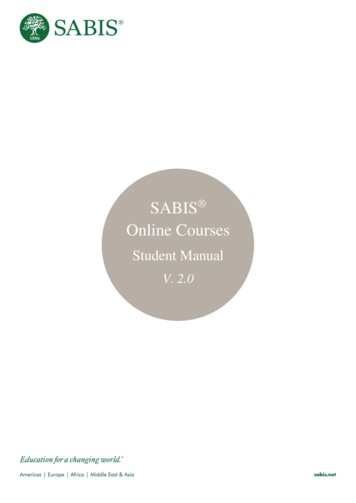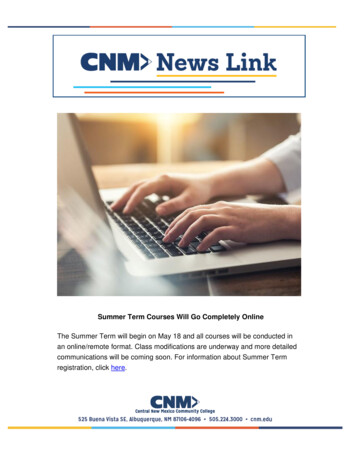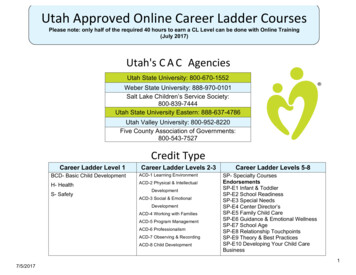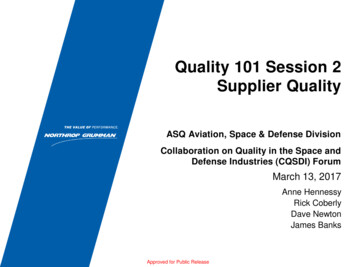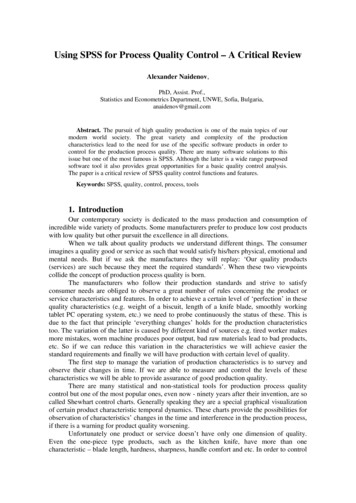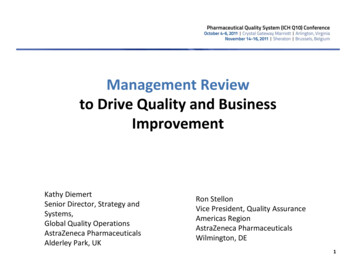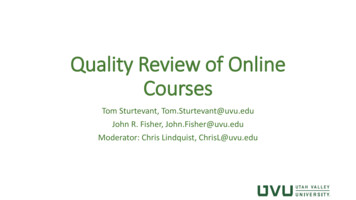
Transcription
Quality Review of OnlineCoursesTom Sturtevant, Tom.Sturtevant@uvu.eduJohn R. Fisher, John.Fisher@uvu.eduModerator: Chris Lindquist, ChrisL@uvu.edu
AbstractThis presentation describes an approach used for quality review ofonline courses. The review considers the following factors: alignment togoals; course technology and tools; design and layout; content andactivities; accessibility; interaction; and assessment and feedback. Theapproach involves the use of a college level Flexible Learning Councilcomprise of faculty and includes training on the course design rubric,inter-rater reliability activity, and external support by the Office ofTeaching and Learning. It provides for standardized quality reviews withbuy-in and support from faculty administration. Lessons learned willbe provided as well as next steps in evaluation of online coursedelivery.
Utah Valley University (UVU) Largest public university in the state of Utah A Dual Mission University Fall 2020 – 40,936 81% of our students work while taking classes 30% are nontraditional (25 ) 37% are first generation
Problem Continued enrollments increases. Online efforts not prioritized. Online course development decentralized. No standardized approach to online efforts. Student demand not met in several areas.
CHPS FLC CommitteeAssociate Dean and Faculty Member co-chairFaculty Representatives from each department:AviationEmergency ServicesCriminal JusticePublic and Community HealthNursingAllied HealthGraduate Programs
Quality Online Review Project - Purpose Expand access of quality courses Develop system for quality review of online courses Replicate a standardized process across the university Meet regional accreditation requirements
Transformative CFLC PilotsQuality Reviews - Summer 2019Summer 2019 PilotFLCCHPSCHSSWSBTotal# of# of# of uniqueReviewers Reviews Courses reviewed71053565418532121819165
CFLC Quality Reviews - Summer 2020As of 8/21/2020CFLCCETCHPSSoACHSSCoSUCWSBTotal# of# of# of uniqueReviewers Reviews Courses reviewed118127118729536127571969394511527954342110
Quality Review Elements/Process CFLC Quality Review Rubric Course Selection Training Quality Review Discussion on Results Follow-up
Quality Review Elements/ProcessCFLCQuality Review Rubric localized version of the Open SUNY Course Quality Rubric (OSCQR) Result of faculty, instructional designers, and administrationcollaboration Also used to support online teaching awards and online teachingcertification
CriteriaUVU Online Course Design RubricOffice of Teaching and LearningSufficientSomeLittle/ NoNotEvidenceEvidenceEvidenceApplicableNotes
1. COURSE INFORMATIONReflection: What does a student need to explicitly know to successfully startand navigate this course?1.Course contains a Syllabus* (accessible PDF or HTML). Required itemsinclude: approved course description, outcomes,Course contains an Instructor Information page*. (Required items includecontact information, communication preferences. Recommended items Course includes links to relevant campus policies.* Required itemsinclude student rights and responsibilities, plagiarism, accessibility services.Course provides access to student success resources* (For exampletechnical help, orientation, tutoring).Course contains instructions for accessing third-party technology tools*(For example publisher websites, secure content, software and hardware Course contains a tone that is supportive of student success.
2. COURSE ALIGNMENTReflection: What parts of the course are best aligned to program goals?1.Course contains learning objectives that are clearly stated and align withcourse outcomes*.Course contains learning content and activities that are aligned withassessments and learning objectives*.3. COURSE TECHNOLOGY AND TOOLSReflection: What technology resources and support do students generally needto confidently complete assignments and activities?3.Course contains opportunities to develop the technical skills required inthe course*. The skills are clearly stated and supported with orientation Frequently used technology tools are easily accessed. Any tools not beingutilized are removed from the course menuCourse contains links to privacy policies for third-party technology tools thatrequire students to create an account outside of Canvas.
4. DESIGN AND LAYOUTReflection: How does your course design and layout alert the students to whatthey should be doing first, next and last?1.Course contains a logical organization and navigation.*Course pages are uncluttered, have information divided into manageablesections, appropriate contrast, formatted text, font, and colors.Course contains clear and concise instructions* that provide a rationale foractivities and assessments. All graded assessments have a written description.Course is free of grammatical and spelling errors.All hyperlinks are functional.
5. CONTENT AND ACTIVITIESReflection: How does the rigor match the level and purpose of this course inpreparing students for lifelong learning and real-world experiences?1.Course contains activities that provide opportunities for engaging inhigher-order thinking as appropriate*. (Examples: Problem-solving,critical thinking, reflection, and analysis.)Course contains engaging learning activities*. (Examples: real-worldapplications, experiential learning opportunities, case studies, andproblem-based activities, as appropriate).Course contains instructional materials that are up-to-date and readilyavailable for students. Where applicable, Open Educational Resources, free,or low-cost materials are used.Course materials and resources include copyright and licensing status,citations, or clearly stated permission to use.*
6. ACCESSIBILITYReflection: How do accessibility measures in your course support studentlearning?1.Course contains content in an easily accessible format*, preferably inHTML that follows current accessibility standards.Course contains text equivalents for non-text elements* (Example:closed-captioning, transcriptions, and alternative text are included for video,audio, and image elements).Course contains hyperlink text that is descriptive* when used out ofcontext. (Example: Avoid use of "click here" in favor of actual website nameor concise description.)Course contains accessible technology tools* that meet WCAG 2.0 AAstandards idebar %23col overview#principle1
7. INTERACTIONReflection: Considering your teaching philosophy, what practices are beingimplemented to create a positive, online learning environment?1.Course facilitates communication, interaction and collaboration*among students and instructor(s) particularly in ways that build community,support open communication, and establish trust.Course contains pacing mechanisms to ensure timely completion of activities,assignments, and assessments.(Examples: Due dates, announcements,reminders, or feedback.)Course contains measures to ensure academic honesty. (Examples: timedquizzes or exams, writing assignments, and uses a plagiarism checker tool.)
8. ASSESSMENT AND FEEDBACKReflection: How are student expectations and progress communicated? Whatopportunities are students given to track and measure their progress and getsupport when needed?1.Course contains frequent and appropriate methods to assess mastery ofcontent*.Course contains clear written criteria for all graded assignments andassessments* (Examples: rubrics, sample work, or templates).Course contains opportunities for students to review their performance andassess their own learning (Example: pre-tests, self-tests, or reflective Course contains clearly stated information for timed responses on quizzes andexams, due dates for discussion posts and deadlines for Course contains a well-organized gradebook. (Note: In Canvas the gradebookis organized based on the Assignments page.)
Quality Review Elements/ProcessCFLCQuality Review RubricCourse Selection & Prioritization Selected by Faculty Factors include: Age of the course,Enrollments,Course data such as grade distribution, withdrawals, fail, etc.Faculty and Staff recommendations
Quality Review Elements/ProcessCFLCQuality Review RubricCourse SelectionTraining Review of rubric Inter-rater reliability activity
Quality Review Elements/ProcessCFLCQuality Review RubricCourse SelectionTrainingQuality Review 3 faculty per course (at least one in subject matter) Occurs within a week timeframe in the summer Use Qualtrics to capture results
Quality Review Elements/ProcessCFLCQuality Review RubricCourse SelectionTrainingQuality ReviewDiscussion on Results Review cumulative resultsDiscussion around non-agreement and little to no evidenceAction to take by CFLC based on reviewsHow to distribute reviews back to faculty
Quality Review Elements/ProcessCFLCQuality Review RubricCourse SelectionTrainingQuality ReviewDiscussion on ResultsFollow-up
Benefits/Lessons Learned Opportunity to identify and take tangible action on courses with deficientquality Reviewers gained perspective by reviewing courses other than their own Avenue to identified and shared examples of excellence Reviewers excited about applying concepts to their own courses Establishes a common vocabulary and understanding related to quality More clearly see the importance of common navigation and format foronline courses Provided a broader perspective of online course practices Change of heart and perspective
Faculty quotes“Using the Course Design Rubric, I redesigned two [of my own]courses this semester to improve standards for accessibility.”“When I evaluated the courses of others, I recognized areaswhere my own courses could improve.”
Next Steps Expanding past just CFLC members to review courses Expanding reviews to other colleges and schools CFLC working this academic year on process to review delivery
Utah Valley University (UVU) Largest public university in the state of Utah A Dual Mission University Fall 2020 – 40,936 81% of our students work while taking classes 30% are nontraditional (25 ) 37% are first generation
